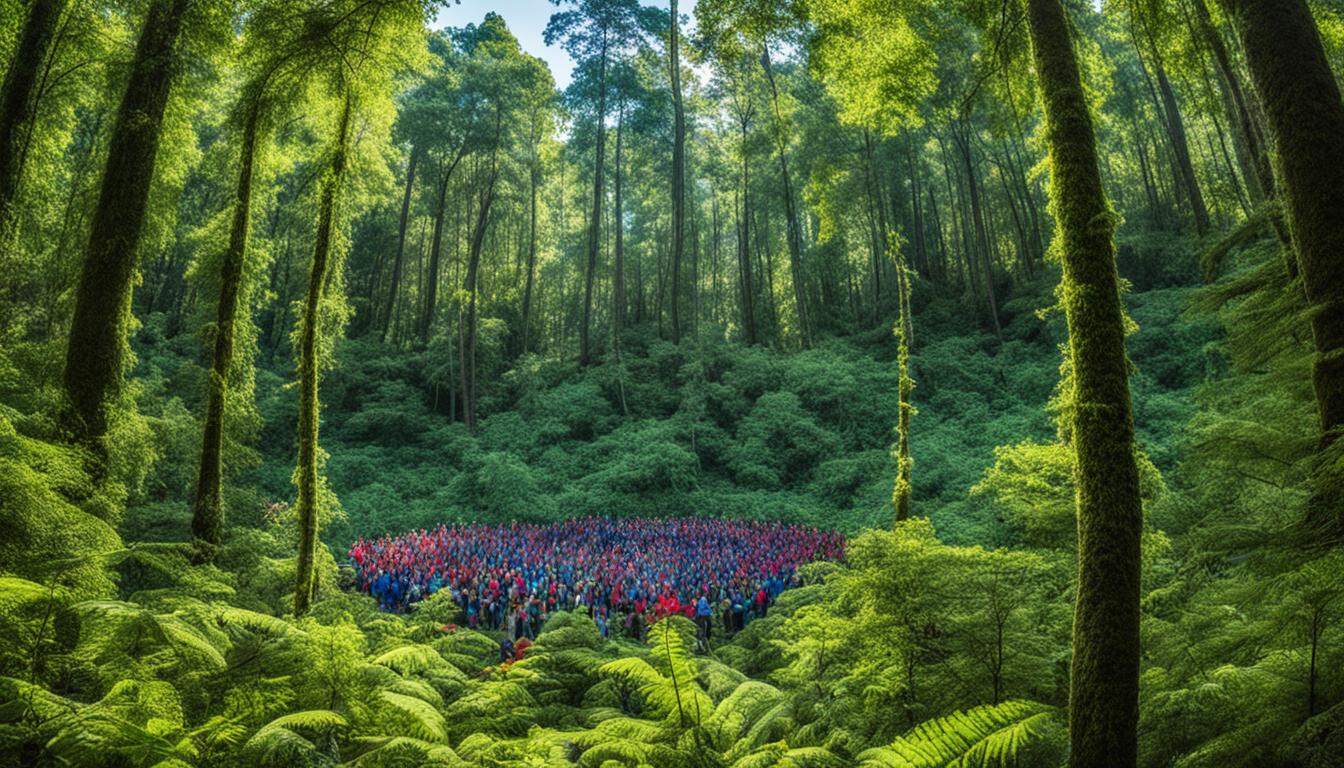Mongolia Biodiversity: Animal and Plant Species and What Is Under Threat
Mongolia occupies a unique ecological transition zone in Central Asia, where various ecosystems, such as the Siberian taiga forest, Central Asian steppe, Altai Mountains, and Gobi Desert, converge. The country boasts diverse natural belts and zones, including the high mountain alpine belt, mountain taiga belt, mountain forest steppe, rolling steppe, and semi-desert and desert zones. There are a significant number of plant and animal species in Mongolia, with over 5,682 plant species, 472 bird species, and 138 mammal species recorded. However, the biodiversity in Mongolia faces threats such as habitat fragmentation, habitat deterioration, water shortages, desertification, and climate change.
Key Takeaways:
- Mongolia is located in a unique ecological transition zone in Central Asia, home to diverse ecosystems.
- There are over 5,682 plant species, 472 bird species, and 138 mammal species in Mongolia.
- Threats to biodiversity in Mongolia include habitat fragmentation, habitat deterioration, and climate change.
- Mongolia’s biodiversity is of utmost importance and requires conservation efforts to protect its remarkable species and ecosystems.
- Conservation initiatives, research, and community engagement are crucial for the future preservation of Mongolia’s biodiversity.
Plant Biodiversity in Mongolia
Mongolia boasts an impressive array of plant species, with over 5,682 recorded. This includes 2,950 vascular plant species, 445 moss species, 999 lichen species, and 1,288 algae species. The country’s diverse plant life plays a crucial role in supporting the local ecosystems and providing essential services.
One notable aspect of Mongolia’s plant biodiversity is the presence of medicinal plants. More than 100 plant species in Mongolia are used for their medicinal properties, and an additional 200 species have valuable pharmaceutical applications.
The country’s forests cover 12.1% of the land and are home to 140 species of trees and shrubs. The dominant tree species in Mongolian forests is the larch. The forested areas not only contribute to the overall plant diversity but also provide key habitats for various wildlife species.
Despite the richness of plant life in Mongolia, there are significant conservation concerns. Over 128 plant species are currently classified as endangered or threatened. Habitat degradation, primarily due to unsustainable land use practices, and the impacts of climate change pose considerable challenges to plant biodiversity in Mongolia.
Threatened Plant Species in Mongolia
| Plant Family | Number of Endangered/Threatened Species |
|---|---|
| Orchidaceae | 35 |
| Lamiaceae | 17 |
| Rosaceae | 12 |
| Asteraceae | 8 |
Wildlife Diversity in Mongolia
Mongolia is known for its diverse wildlife, that contributes to the country’s rich biodiversity. With 138 mammal species and 472 bird species recorded, Mongolia is a haven for nature enthusiasts and wildlife researchers.
One of the remarkable features of Mongolia’s wildlife is its role as a critical stopover and breeding ground for many migratory bird species. Four major global migratory routes pass through Mongolia, providing essential resting and feeding areas for these remarkable avian travelers.

In addition to migratory birds, Mongolia is home to several unique mammal species, such as the native wild horse, Przewalski’s horse. This iconic species was successfully re-introduced to the wild in the early 1990s, after facing extinction.
However, wildlife in Mongolia is not without its challenges. The increasing threats of hunting, habitat loss, and climate change pose significant risks to the survival of many animal species. Mammal populations, including the once-abundant red deer, have experienced dramatic declines, necessitating urgent conservation actions.
A comprehensive understanding of Mongolia’s wildlife diversity is crucial for effective conservation strategies and the preservation of this unique natural heritage.
Threats to Biodiversity in Mongolia
Mongolia’s rich biodiversity faces several threats that pose significant challenges to its conservation and sustainability. These threats include habitat fragmentation, habitat deterioration, desertification, water shortages, and the impact of climate change. Each of these factors contributes to the decline in biodiversity and disrupts the delicate balance of Mongolia’s ecosystems.
Habitat fragmentation, caused by human activities such as road construction and urbanization, results in the division of natural habitats into smaller, isolated patches. This fragmentation restricts the movement of wildlife and disrupts ecological processes, leading to a loss of biodiversity.
Habitat deterioration, primarily through overgrazing and land use changes, has contributed to the degradation of Mongolia’s extensive grasslands. Overgrazing by livestock has reduced vegetation cover and altered the structure of grassland ecosystems, affecting the survival of plant and animal species.
Desertification is a significant concern in Mongolia, with over three-quarters of the country’s total area affected. As desertification progresses, it negatively impacts the biodiversity of the affected regions, particularly mammal species that rely on underground habitats.
Water shortages have emerged as a critical issue in Mongolia, with the drying up of water sources and the deterioration of aquatic and marshy ecosystems. These changes in water availability disrupt the habitats of various plant and animal species, threatening their survival.
Climate change further exacerbates the challenges faced by Mongolia’s biodiversity. The country has experienced increased droughts, extreme weather events, and rising temperatures, all of which have profound impacts on ecosystems and species. Changes in climate patterns can disrupt plant and animal life cycles, alter habitats, and increase the vulnerability of species to other threats.
Another significant concern is the increased occurrence of fires, both natural and human-caused, which pose a threat to forests and steppes. These fires lead to habitat loss, reduce biodiversity, and contribute to the decline in wildlife populations.
Efforts to address these threats and protect Mongolia’s biodiversity are crucial. Conservation initiatives, such as promoting sustainable land use practices, implementing effective measures to combat desertification, and mitigating the impacts of climate change, are essential for safeguarding the unique ecosystems and species that call Mongolia home.

By prioritizing nature conservation and raising awareness about the importance of biodiversity, Mongolia can work towards a sustainable future where its natural heritage thrives. The next section will delve into the conservation efforts being made in Mongolia to tackle these challenges and preserve its extraordinary biodiversity.
Conservation Efforts in Mongolia
Mongolia has demonstrated a strong commitment to preserving its rich biodiversity through various conservation initiatives.
One of the key steps taken by the country is the establishment of protected areas, with 14% of Mongolia’s territory designated as special protected areas. These areas serve as sanctuaries for wildlife and plants, safeguarding their habitats and ensuring their long-term survival. Notably, six of these areas have been recognized as World Heritage sites and UNESCO’s Man and the Biosphere reserves, further highlighting their ecological significance.
To ensure the effective conservation of biodiversity, the Mongolian government has enacted laws and regulations that protect wildlife, plants, and their habitats. The Law on Environmental Protection, Law on Wildlife, and Law on the Protection of Plants are instrumental in maintaining the delicate balance of Mongolian ecosystems.
Furthermore, Mongolia is actively implementing the National Biodiversity Conservation Action Plan, which outlines strategies and actions to promote biodiversity conservation across the country. As part of this plan, the government aims to increase the coverage of protected areas to 30%, ensuring a more comprehensive network of sanctuaries for species conservation.
Protected Areas in Mongolia
Mongolia’s protected areas are integral to its biodiversity conservation efforts. These areas provide vital habitats for numerous species and contribute to the overall preservation of Mongolian ecosystems. Here are some of the notable protected areas in Mongolia:
| Name | Location | Size (hectares) | Status |
|---|---|---|---|
| Great Gobi Special Protected Area | Gobi Desert | 9,000,000 | Special Protected Area |
| Altai Tavan Bogd National Park | Altai Mountains | 636,200 | World Heritage Site |
| Astapovo-Garamurun Nature Reserve | Khentii Mountains | 48,490 | Man and the Biosphere Reserve |
| Khustain Nuruu National Park | Khentii Mountains | 50,620 | Special Protected Area |
These protected areas, along with many others in Mongolia, serve as crucial strongholds for biodiversity conservation. They provide a safe haven for endangered species, support ecological research, and promote sustainable tourism.

The image above showcases the diverse wildlife found within Mongolia’s protected areas. It highlights the importance of these sanctuaries in preserving the unique species that inhabit the country.
In addition to government-led initiatives, various organizations and communities are actively engaged in biodiversity conservation in Mongolia. Non-governmental organizations, research institutions, and local communities contribute their expertise and efforts to protect and sustain the nation’s biodiversity.
The conservation efforts in Mongolia are crucial not only for the country but also for global biodiversity conservation. By preserving its unique ecosystems and species, Mongolia plays a vital role in maintaining the delicate balance of our planet’s biodiversity.
Biodiversity Research and Monitoring in Mongolia
Biodiversity research and monitoring play a vital role in understanding and conserving Mongolia’s diverse ecosystems. Through collaboration between government agencies, research institutions, and international partners, numerous projects aim to document and study the plant and animal species found in Mongolia.
Partnerships for biodiversity research in Mongolia facilitate the collection of valuable data that provides insights into the status and trends of biodiversity in the country. This information is crucial for guiding conservation strategies and management plans.

Long-term biodiversity monitoring in Mongolia ensures that changes in species diversity and abundance are tracked over time. This monitoring allows scientists to assess the impact of various factors, such as climate change and habitat degradation, on the country’s biodiversity.
Biodiversity research in Mongolia employs various methods, including field surveys, genetic analysis, and remote sensing. These interdisciplinary approaches provide a comprehensive understanding of the ecosystems and the species they support.
The partnership between researchers, government agencies, and local communities strengthens the conservation efforts in Mongolia. By engaging with local stakeholders, scientists gain access to valuable indigenous knowledge about the environment and cultural practices that can contribute to sustainable land use and wildlife conservation.
Overall, biodiversity research and monitoring are essential for protecting and preserving the rich natural heritage of Mongolia. They provide the foundation for informed decision-making and effective conservation practices that will ensure the long-term survival of the country’s unique ecosystems and species.
Challenges and Future Outlook for Mongolia’s Biodiversity
Mongolia’s biodiversity faces numerous challenges, including climate change, habitat loss, overgrazing, and unsustainable land use practices. The impact of climate change, particularly increased droughts and desertification, poses a significant risk to ecosystems. The increasing size of livestock herds and their encroachment into the habitats of wild animals further exacerbate the challenges.
“Climate change poses a significant risk to Mongolia’s biodiversity, and urgent actions are required to mitigate its impact,” warns Dr. Altangerel Batbold, a leading expert in Mongolian nature conservation.
However, there is hope for the future, as Mongolia has demonstrated its commitment to preserving its natural heritage. The government has pledged to increase nature conservation spending to 1% of GDP, reflecting the importance of protecting biodiversity and addressing the conservation challenges the country is facing.
To ensure the future preservation of Mongolia’s biodiversity, concerted efforts are required to restore and rehabilitate ecosystems, strengthen conservation laws, and raise awareness among local communities. The implementation of sustainable land use practices is crucial, as it can help mitigate the negative impacts of overgrazing and unsustainable practices on biodiversity.
| Conservation Challenges in Mongolia | Impact |
|---|---|
| Climate change | Increased droughts and desertification |
| Habitat loss | Fragmentation and deterioration of habitats |
| Overgrazing | Deterioration of grasslands and competition for resources |
| Unsustainable land use practices | Loss of biodiversity and ecosystem services |
Efforts to address these challenges can help secure a sustainable future for Mongolia’s biodiversity and ensure the conservation of its unique ecosystems for generations to come.

The Importance of Biodiversity Conservation in Mongolia
Biodiversity conservation plays a critical role in preserving the rich natural heritage of Mongolia and has far-reaching benefits for both ecosystems and local communities. Mongolia’s diverse ecosystems provide a range of ecosystem services that are essential for the well-being of both wildlife and human populations.
One of the key ecosystem services is water regulation, where Mongolia’s unique landscapes act as natural filters, ensuring a steady flow of clean water. These ecosystems also contribute to climate regulation by absorbing carbon dioxide and mitigating the impacts of climate change. Additionally, the diverse flora in Mongolia helps maintain soil fertility by preventing erosion and promoting nutrient cycling.
The genetic diversity found in Mongolia’s plants and animals is of immense value and holds great potential for improving crops and developing medicines. The genetic resources present in Mongolia’s unique ecosystems can provide solutions to future challenges, such as disease resistance and new pharmaceutical discoveries.
Moreover, the presence of unique wildlife and stunning landscapes in Mongolia attracts tourists from around the world, contributing to eco-tourism and cultural heritage preservation. The economic benefits derived from tourism help support local communities and provide opportunities for sustainable development.

Local Communities and Biodiversity Conservation in Mongolia
Local communities play a vital role in the conservation of Mongolia’s biodiversity. With their rich traditional knowledge and practices, they contribute to sustainable land use and wildlife conservation efforts. By engaging local communities in conservation initiatives, we can foster the development of community-based conservation projects, which not only promote sustainable livelihoods but also enable communities to reap the benefits of protecting and preserving their natural heritage.
Recognizing and valuing indigenous knowledge and practices is essential for successful biodiversity conservation in Mongolia. Local communities have a deep understanding of their ecosystems and the intricate connections between various species. Their insights can inform conservation strategies and help maintain the delicate balance of the Mongolian ecosystem.

Through collaborative efforts, we can harness the wealth of indigenous knowledge and empower local communities to actively participate in biodiversity conservation. By building strong partnerships between researchers, government agencies, and community leaders, we can ensure that conservation efforts align with the needs and values of the local people.
Community-based conservation not only strengthens the resilience of Mongolia’s ecosystems but also offers sustainable livelihood opportunities for local communities. By promoting practices such as nature-based tourism and sustainable resource management, we can create economic benefits directly tied to biodiversity conservation. This synergy between sustainable livelihoods and conservation fosters a sense of ownership and responsibility, cultivating a long-term commitment to protecting Mongolia’s rich biodiversity.
Conclusion
Mongolia’s extraordinary biodiversity is a treasure that faces significant threats. However, with dedicated conservation efforts, ongoing research, and meaningful community engagement, there is a glimmer of hope for the future. Preserving Mongolia’s rich biodiversity is not only crucial for the country itself, but also for maintaining global ecological balance and ensuring the well-being of future generations.
To safeguard the diverse ecosystems and the remarkable species they harbor, it is imperative to continue investing in biodiversity conservation. This includes implementing sustainable land use practices, mitigating the effects of climate change, and fostering partnerships between government institutions, research organizations, and local communities.
By prioritizing the preservation of Mongolia’s natural heritage, we can not only protect its unique ecosystems but also benefit from the valuable ecosystem services they provide. From regulating water and climate to maintaining soil fertility and supporting sustainable livelihoods, the importance of conservation efforts in Mongolia cannot be overstated.
Looking ahead, we must remain committed to the long-term survival of Mongolia’s biodiversity. Through collective action and a shared responsibility, we can ensure that future generations can continue to marvel at the wonders of Mongolia’s natural world and appreciate the vital role it plays in our global ecosystem.
FAQ
What is the biodiversity like in Mongolia?
Mongolia has a diverse range of ecosystems, including the Siberian taiga forest, Central Asian steppe, Altai Mountains, and Gobi Desert. It is home to over 5,682 plant species, 472 bird species, and 138 mammal species.
What are the threats to biodiversity in Mongolia?
Biodiversity in Mongolia faces threats such as habitat fragmentation, habitat deterioration, water shortages, desertification, and climate change.
Are there endangered species in Mongolia?
Yes, there are over 128 endangered or threatened plant species and many mammal species, including the red deer, have seen drastic population declines.
What conservation efforts are being made in Mongolia?
Mongolia has established protected areas, with 14% of its territory designated as special protected areas. The government has enacted laws and regulations to protect wildlife, plants, and their habitats and is implementing the National Biodiversity Conservation Action Plan.
What is the role of biodiversity research in Mongolia?
Biodiversity research and monitoring play a vital role in understanding and conserving Mongolia’s diverse ecosystems. These efforts involve collaborations between government agencies, research institutions, and international partners.
What are the challenges and future outlook for Mongolia’s biodiversity?
Challenges include climate change, habitat loss, overgrazing, and unsustainable land use practices. The future outlook depends on continued investments in conservation, sustainable land use, and climate change mitigation.
Why is biodiversity conservation important in Mongolia?
Biodiversity conservation in Mongolia is important as it provides essential ecosystem services, economic benefits, and contributes to eco-tourism and cultural heritage preservation.
What is the role of local communities in biodiversity conservation in Mongolia?
Local communities play a vital role in biodiversity conservation in Mongolia. Their traditional knowledge and practices can contribute to sustainable land use and wildlife conservation.
How can I get involved in biodiversity conservation in Mongolia?
Getting involved in biodiversity conservation in Mongolia can be done by supporting conservation organizations, participating in community-based initiatives, and spreading awareness about the importance of conservation.








